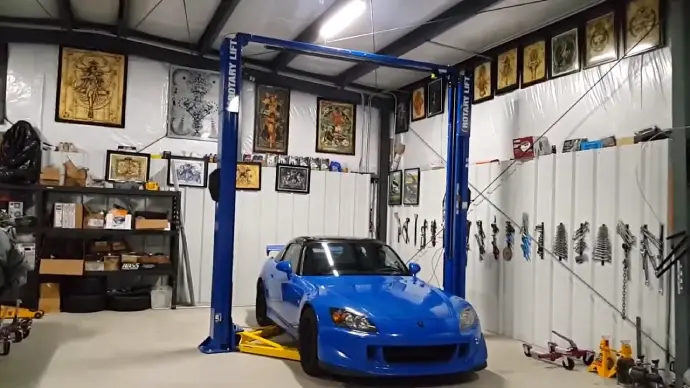Last Updated on May 29, 2023
Two-post car lifts are essential equipment for automotive shops and DIY enthusiasts. But many people may question their safety. There are concerns about the stability and safety of two-post car lifts, particularly when lifting heavy vehicles.
Do you want to know and learn why two-post car lifts are safe and reliable? Several safety features make them reliable and secure. We will explore the reasons why two-post lifts are secure and debunk common myths about their safety.
Among all, we will discuss automatic locking systems, overhead bars, and limit switches, as well as auxiliary safety features like alarms and lights. By the end of this blog, you will have the knowledge and confidence to take action and safely use a two-post car lift in your garage or shop.
Are 2 Post Car Lifts Safe: 3 Reasons
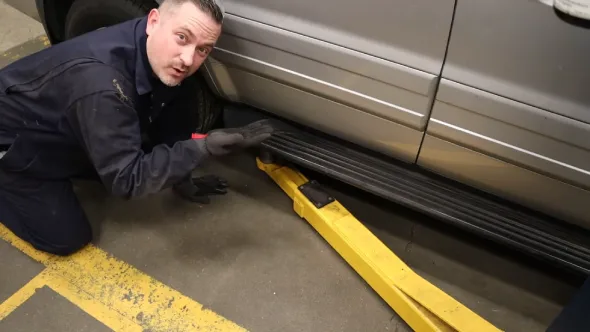
Safety Reason 01. Automatic Locking Systems
Automatic locking systems used in two-post car lifts are created to secure the lifting arms and prevent the vehicle from descending in case of a power outage, hydraulic failure, or other malfunction. There are two types of automatic locking systems commonly found in two-post car lifts:
Mechanical locks
These use a set of pins or latches that engage with holes on the lifting arms to hold them in position. A lever or a pneumatic cylinder typically actuates the locking mechanism.
Hydraulic locks
These use hydraulic pressure to lock the lifting arms. When the lift is raised, hydraulic pressure is used to release the locks and allow the arms to move freely. When the lift is lowered, hydraulic pressure is applied to engage the locks and secure the arms.
To prevent malfunctions that could lead to accidents, these automatic locking systems are typically equipped with safety features such as:
- Automatic safety latches that engage if the main locking mechanism fails.
- Cable slack sensors detect if the lifting cables become loose.
- Hydraulic safety valves prevent the lift from lowering if there is a loss of hydraulic pressure.
- Safety shutoff switches disable the lift if any of the safety systems are triggered.
Safety Reason 02. Overhead Bar and Limit Switch
The overhead bar and limit switch are crucial safety features of two-post car lifts. The overhead bar acts as a physical barrier that prevents the lift from raising beyond a safe height. At the same time, the limit switch automatically stops the lift once it reaches its maximum or minimum height.
Overhead Bar
The overhead bar is typically positioned above the vehicle’s roof and is attached to the lift’s carriage or overhead structure. When the lift reaches the predetermined maximum height, the bar will contact the vehicle’s roof, preventing the lift from going further.
Limit Switch
The limit switch, on the other hand, is an electrical safety device that stops the lift from operating once it goes to its maximum or minimum height. The switch is typically installed on the lift’s hydraulic cylinder or carriage and is activated when the lift reaches a predetermined height.
If the lift continues to operate and reaches the limit switch, it will automatically shut off, preventing the lift from raising or lowering any further.
Safety Reason 03. Auxiliary Safety Features Such As Alarms and Lights
Two-post car lifts often have auxiliary safety features to help prevent accidents and injuries. Some common features include alarms, warning lights, and automatic shut-off mechanisms. When activated, these features alert the user to any potential safety hazards, such as overloading the lift or improperly positioning the vehicle.
For example, an overload alarm may sound if the weight of the vehicle exceeds the lift’s maximum capacity, and a warning light may indicate if the lift’s locking mechanisms are not engaged properly. The effectiveness of these auxiliary safety features depends on their design, installation, and maintenance.
Properly functioning and well-maintained alarms and warning lights can help prevent accidents and injuries by quickly alerting the user to any potential hazards. Additionally, automatic shut-off mechanisms can help prevent accidents by stopping the lift’s operation if a safety hazard is detected.
Common Misconceptions About Two-Post Car Lifts
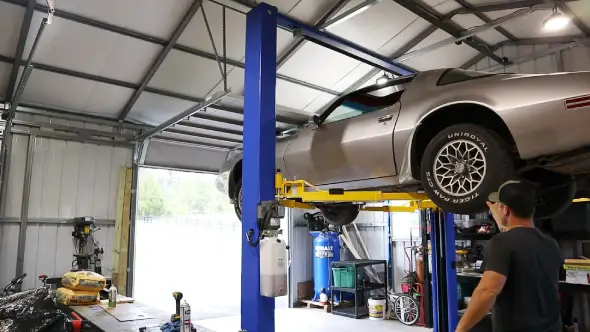
This section refers to misunderstandings or incorrect beliefs people may have about two-post car lifts. A two-post vehicle lift is a piece of equipment commonly used in automotive repair shops to lift vehicles off the ground, allowing mechanics to work on the underside of the vehicle.
Misconception 1: Two-post car lifts are not stable
The common misperception that two-post car lifts are unstable may stem from several reasons. One of them is that people often associate the idea of stability with a four-post lift, which provides a larger base for support.
There might be concerns regarding the design of two-post lifts that involve the balance and distribution of weight. The structural design of trendy two-post car lifts provides ample stability and support for the lifted vehicle.
The two posts are anchored to the ground and connected by a sturdy crossbar, which creates a solid foundation for the lift. The arms that hold the vehicle in place are also designed to distribute weight evenly, and the hydraulic system that raises and lowers the lift is engineered to provide smooth and controlled movement.
Modern two-post car lifts have addressed concerns about stability by implementing safety features that prevent accidents. For instance, many lifts have automatic safety locks that engage when the lift is raised, preventing it from lowering unintentionally.
Others feature backup safety systems in case of power failure or hydraulic malfunction. Some lifts also have padded and adjustable arms that can be positioned to lift the vehicle at specific points, preventing damage to the undercarriage.
Many lifts come with safety features such as warning buzzers, visual indicators, and emergency stop buttons that allow operators to stop the lift, if necessary, quickly.
Misconception 2. Two-post Car Lifts Are Prone To Mechanical Failure
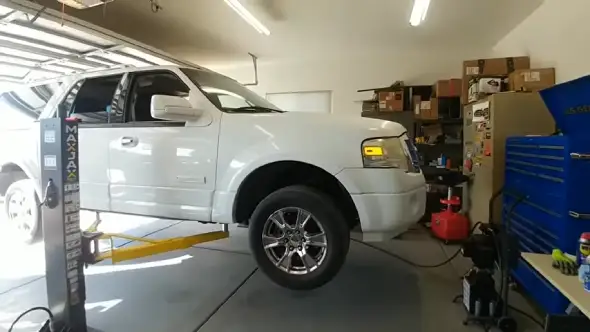
The misconception that two-post car lifts are tending to mechanical failure is not entirely accurate. While it’s true that older models may have been prone to mechanical issues, new two-post car lifts are engineered to be reliable, durable, and safe.
The Durability Of Modern Two-Post Car Lifts
Modern two-post car lifts are devised to be durable and long-lasting. They are built with high-quality materials such as thick steel plates, high-strength aircraft-grade cables, and heavy-duty hydraulic cylinders.
These lifts also have safety features, such as automatic locking systems that prevent the lift from falling in case of a mechanical failure.
Measures To Ensure Longevity And Reliability
Manufacturers take several measures to ensure the longevity and reliability of two-post car lifts. For instance, regular inspection and maintenance schedules are recommended to ensure a lift is in good working condition.
Manufacturers offer regular training to their technicians to ensure they are familiar with the latest technologies and are up-to-date with the latest safety standards.
What Safety Features Should You Look For When Choosing A Two-Post Car Lift?
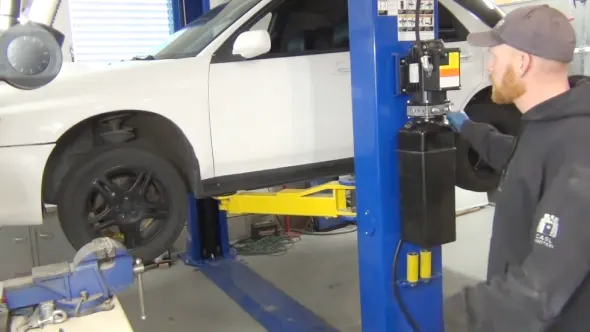
When preferring a two-post car lift, safety should be one of your top priorities. Here are some safety features that you should look for:
- Safety Locks: Look for a lift with safety locks on the lifting arms. Safety locks keep the lift from dropping unexpectedly and provide a secure lock to hold the car in place while it is being worked on.
- Automatic Shut-off: Select a lift that has an automatic shut-off system. This system will automatically stop the lift from operating if it reaches its maximum height or if there is a problem with the hydraulic system.
- Overload Protection: Choose a lift that has overload protection. This safety feature will prevent the lift from working if it is carrying too much weight.
- Rubber Pads: Pick a lift that has rubber pads on the lifting arms. These pads will help to prevent damage to the vehicle’s undercarriage.
- Sturdy Construction: Choose a lift that is made of high-quality materials and has a sturdy construction. This will ensure that the lift can safely support the weight of the vehicle.
- Safety Barriers: Look for a lift that has safety barriers or warning devices that prevent a vehicle from accidentally driving off the lift.
- Certification: Choose a lift that has been certified by an industry-standard organization, such as the Automotive Lift Institute (ALI). This certification ensures that the lift has been independently tested and meets strict safety standards.
Always follow the manufacturer’s instructions and safety guidelines when using a car lift to ensure a safe and successful repair or maintenance job.
How Does The Maximum Weight Capacity For A Typical Two-Post Car Lift Impact Safety?
The maximum weight-carrying capacity for a standard two-post car lift can vary depending on the specific model and manufacturer. Still, most are designed to lift vehicles weighing up to 10,000 pounds (4536 kg).
The maximum weight capacity of a two-post car lift is a critical factor in ensuring safety. Exceeding the weight capacity can stress the lift components, potentially leading to mechanical failure, which could result in serious injury or death.
The vehicle’s weight must be evenly distributed on the lift arms to prevent the lift from becoming unbalanced and tipping over. To ensure safe operation, select a two-post car lift with a weight capacity appropriate for the vehicles you will be lifting.
Follow the manufacturer’s guidelines for use, including load distribution, and to perform regular maintenance to ensure the lift remains in good working condition.
What Safety Checks Should Be Performed Before Using A Two-Post Car Lift?
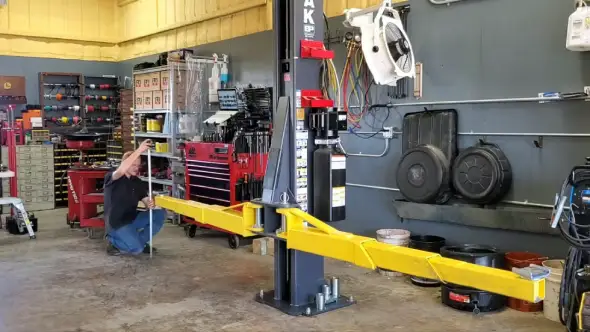
Operating a two-post car lift can be a convenient way to access the undercarriage of a vehicle for repairs, maintenance, or inspections.
Perform several safety checks before utilizing a two-post car lift to ensure that the lift is functioning properly and is safe to use. Some safety checks to perform before employing a two-post car lift include:
- Inspect the lift structure: Before working with a two-post car lift, inspect the entire structure to ensure that all bolts and welds are secure and that there are no visible signs of damage or wear.
- Check the lifting arms: Make sure that the lifting arms are properly attached to the posts and that they move smoothly up and down. Ensure that the arms have no signs of wear or damage, such as cracks or bends.
- Verify the safety locks: Ensure that the safety locks engage and disengage properly and that they are in good condition. The safety locks prevent the lift from lowering unexpectedly and are a crucial safety feature.
- Confirm the hydraulic system: Check the hydraulic fluid level and make sure that there are no leaks or damage to the hydraulic lines. The hydraulic system is responsible for lifting the vehicle, and any leaks or damage could cause the lift to fail.
- Check the load capacity: Make sure that the lift’s load capacity is appropriate for the vehicle you are lifting. Exceeding the weight limit of the lift could cause it to fail and result in injury or damage to the vehicle.
- Check the lift’s position: Ensure that the lift is properly positioned and leveled on the ground and that the vehicle is centered on the lift. Using the lift on an uneven or sloped surface could cause the lift to tip over.
By performing these safety checks, you can ensure that the two-post car lift is safe to use and prevent accidents or injuries. If you have any doubts about the safety of the lift, do not use it until the necessary repairs or maintenance have been performed.
Two-Post Car Lifts: A Safe and Reliable Option for Vehicle
Two-post car lifts are designed to be highly safe to use. From automatic locking systems, limit switches, and overhead bars to auxiliary safety features such as lights and alarms, two-post car lifts offer different types of protection that can help keep users safe when using them.
Despite common misconceptions, contemporary two-post car lifts are durable and reliable if properly maintained.
Users can feel confident knowing that their two-post car lift will provide them with years of secure use by taking the necessary steps to ensure their longevity, such as performing regular maintenance checks and using OEM parts for repairs.
Ultimately, the combination of advanced engineering technology, state-of-the-art safety equipment, and proper maintenance will allow users to experience a secure lifting environment each time they rely on a two-post car lift.
